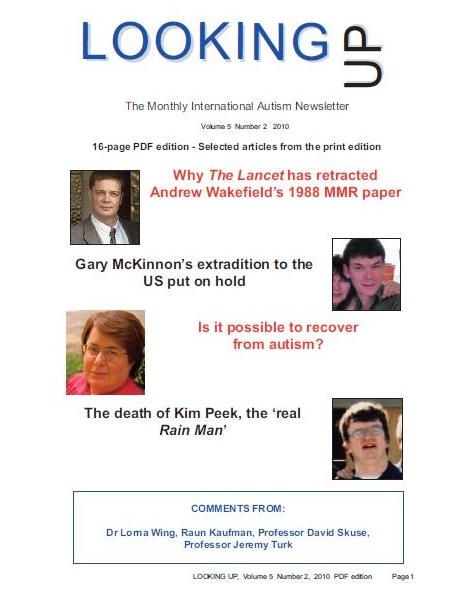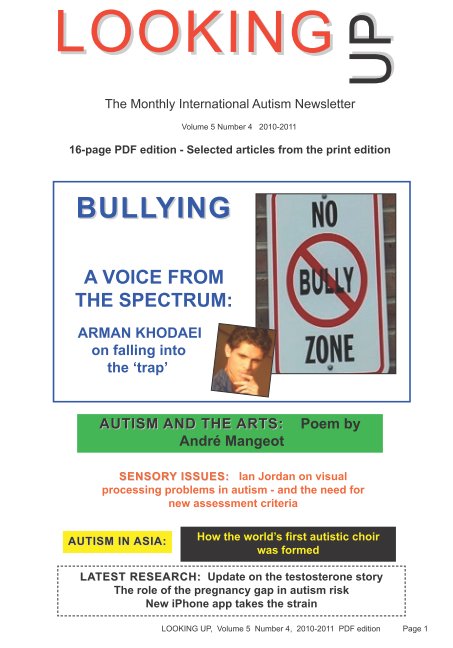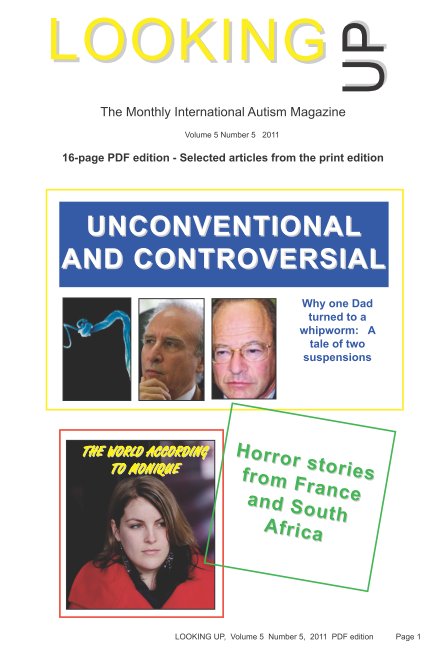Looking Up, 16-page English PDF Edition, Back Issues and Current Issue

|

|

|

|

|

|

|

|
| Home page | Subscribe (print edition) | Selected articles | Our publications | Our mailing lists |
| PDF edition | Subscribe (PDF edition) | Back issue contents | Autism books | Contact us |
From Volume 5 Number 6 (Print and PDF editions)
SACRAMENTO, California, USA: A new study has linked regressive autism with larger brain size in boys. In regressive autism, children appear to develop normally or near normally and then markedly lose language and social skills between 18 and 24 months.
The researchers did not find larger heads and bigger brains among girls with regressive autism or children of either gender with early-onset autism, which emerges by about the age of one.
Other studies have suggested some association between overgrowth of the brain and autism. The new study, led by researchers at the UC Davis MIND Institute, demonstrates that there are multiple biological subtypes of autism including likely differences between males and females.
Researchers looked at 114 children with autism spectrum disorder between the ages of two and four and compared them with 66 healthy children of the same age. Of the 114 with the disorder, 54 per cent had regressive autism and 46 per cent had non-regressive autism.
Brain scans of the children showed that abnormal head growth and brain enlargement was identifiable in 22 per cent of males with regressive autism compared with 5 per cent of males with the non-regressive type. Girls with autism did not show brain enlargement. The data suggest that the abnormal brain growth occurred at around four to six months of age, much earlier than the symptoms of regression - such as a decline in speech - actually appear.
The study, published on November 28 in the Proceedings of the National Academy of Sciences, adds to a growing body of evidence showing that autism probably has various biological underpinnings.
Researchers are particularly interested in understanding the disorder in girls. “[It] is likely that the pattern of pathology is different in females from in males,” they wrote.
Even though the symptoms of regressive autism do not become obvious until children are approaching their second birthday, the findings suggest that whatever processes are occurring that lead to it start much earlier.
“At birth, you couldn’t detect a difference. But at around four to six months of age, the kids who had regressive autism started deviating and their brains were significantly larger than the typically developing children,” said the senior study author, Dr David Amaral, research director of the MIND Institute and a professor of psychiatry and behavioural sciences at University of California, Davis.
“Parents are often worried that what caused their child’s regression is something that happened to them just before the regression takes place. Our data suggest that this may not be the case. It’s an ongoing process that starts when the children are younger and you only see it when the process has reached a critical stage,” Dr Amaral explained.

|

|

|

|

|

|

|

|
| Current 40-page print edition issue | |||||||||||||||
|---|---|---|---|---|---|---|---|---|---|---|---|---|---|---|---|

|
| ||||||||||||||
| PRINT EDITION BACK ISSUE CONTENTS AND FRONT COVERS | ||||||||||||||||||||||||||
|---|---|---|---|---|---|---|---|---|---|---|---|---|---|---|---|---|---|---|---|---|---|---|---|---|---|---|
| VOLUME 1, Number: | 1 | 2 | 3 | 4 | 5 | 6 | 7 | 8 | 9 | 10 | 11 | 12 | VOLUME 2, Number: | 1 | 2 | 3 | 4 | 5 | 6 | 7 | 8 | 9 | 10 | 11 | 12 | |
| VOLUME 3, Number: | 1 | 2 | 3 | 4 | 5 | 6 | 7 | 8 | 9 | 10 | 11 | 12 | VOLUME 4, Number: | 1 | 2 | 3 | 4 | 5 | 6 | 7 | 8 | 9 | 10 | 11 | 12 | |
| VOLUME 5, Number: | 1 | 2 | 3 | 4 | 5 | 6 | 7 | 8 | ||||||||||||||||||
| You can find our PDF EDITION CONTENTS AND COVERS on our PDF EDITION BACK ISSUES PAGE | ||||||||||||||||||||||||||
| Home page | Subscribe (print edition) | Selected articles | Our publications | Our mailing lists |
| PDF edition | Subscribe (PDF edition) | Back issue contents | Autism books | Contact us |